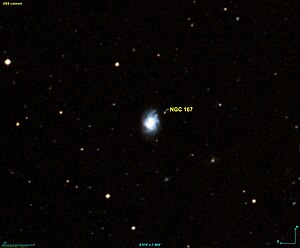NGC 167
| Galaxy NGC 167 |
|
|---|---|

|
|
| AladinLite | |
| Constellation | whale |
|
Position equinox : J2000.0 , epoch : J2000.0 |
|
| Right ascension | 00 h 35 m 23.1 s |
| declination | -23 ° 22 ′ 30 ″ |
| Appearance | |
| Morphological type | SB (r) c? / HII |
| Brightness (visual) | 13.7 mag |
| Brightness (B-band) | 14.4 mag |
| Angular expansion | 1.00 ′ × 0.7 ′ |
| Position angle | 171 ° |
| Surface brightness | 13.2 mag / arcmin² |
| Physical data | |
| Redshift | 0.012812 ± 0.000040 |
| Radial velocity | 3841 ± 12 km / s |
|
Stroke distance v rad / H 0 |
(172 ± 12) · 10 6 ly (52.8 ± 3.7) Mpc |
| history | |
| discovery | Francis P. Leavenworth |
| Discovery date | 1886 |
| Catalog names | |
| NGC 167 • PGC 2122 • ESO 473-029 • MCG -04-02-022 • IRAS 00328-2339 • 2MASX J00352309-2322300 • SGC 003254-2339.1 • NVSS J003522-232222 | |
NGC 167 is a bar-spiral galaxy with extensive star formation areas of the Hubble type SBc in the constellation Whale south of the celestial equator . It is estimated to be 172 million light years from the Milky Way and about 50,000 light years in diameter .
The galaxies NGC 168 , NGC 172 , NGC 177 are located in the same area of the sky .
The object was discovered in 1886 by the American astronomer Francis Preserved Leavenworth .
